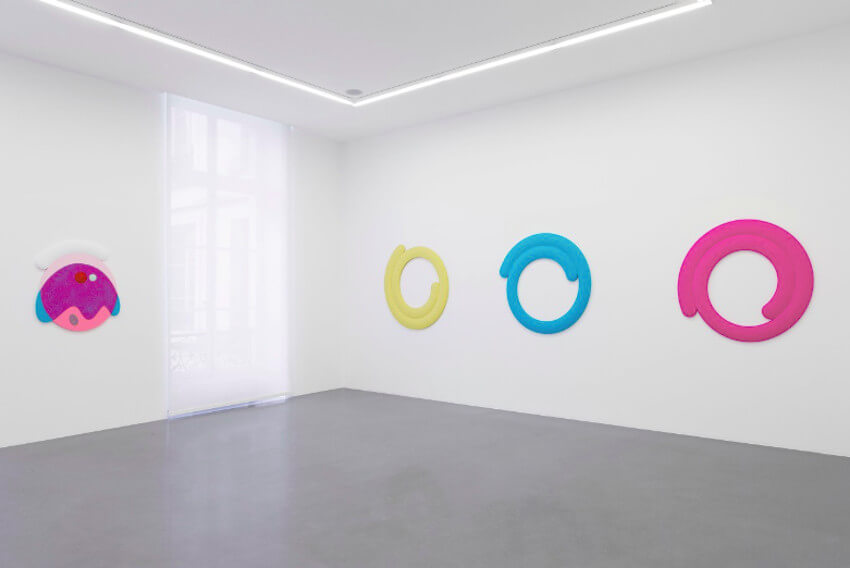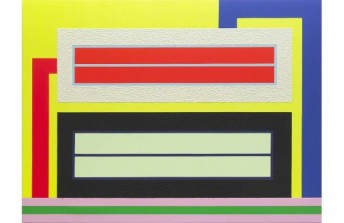Behind Josh Sperling’s Dynamic “Composites”
Mar 23, 2018
American artist Josh Sperling recently wrapped up his first international solo exhibition, at Perrotin, Paris. The work was colorful and whimsical—a perfect introduction to what Sperling does. One gallery wall supported an installation of 48 squiggly forms, each painted a different color, hung together in a well-balanced, amusing looking composition; the squiggles resemble something in between Play-Doh Fun Factory pasta noodles and squirts of multi-colored toothpaste. On the other walls hung new composites—constructed reliefs Sperling makes out of combinations of shaped canvases and panels. Some of his composites resemble recognizable things, such as an ice cream cone, a donut, a hair tie, or a human face. Others look like a spilled assortment of craft materials—something found on the floor of a pre-school. The work is not intended by Sperling to contain figurative references; it is purely abstract. Sperling titled the exhibition Chasing Rainbows. He said he chose the title because it seemed mysterious. He called it, “intangible, but also fun.” In general, that is the perfect description of his work. It is intangible: each piece is something, but its presence is hard to grasp. And it is undeniably fun, at least to look at: it is bright, light, and it seems to ask nothing more from us than the most basic consideration we might give to a patch of sunshine on the street, or a brightly colored piece of gum we happen to see on the sidewalk. Most of all, it is simple, in the best way. The work possesses no agenda, other than to inspire happiness, and possesses no content, other than whatever story we, the viewers, choose to bestow upon it.
The Beauty of Method
When I first saw the work in Chasing Rainbows I thought it seemed familiar. I could not say why, exactly. There was just something about it I recognized. My art writer instinct was to interrogate it—to scan my memories of art history in search of that from which it might have been derived. I forced a couple of quick connections. The first was the Memphis Group, a mid-1980s design movement, recently resurged in popularity, which was reliant on fanciful geometric and biomorphic forms painted in bright, primary colors. Next, I thought of Elizabeth Murray, and her fantastically engaging constructions, which jump off the wall with the excitement of comic book fight scenes. Then I stopped myself, remembering how unfair it is to compare what one person does to the things other people have done. I looked at this work again as though it was derived only from the mind of Sperling. From this point of view, I saw it for what it really is—play.

Josh Sperling - Chasing Rainbows, installation view at Perrotin Paris, France, 2018, photo courtesy Perrotin
When Sperling is in the studio, he is like a kid at recess, but just any kid—that one really smart kid who takes his playtime seriously. He begins every new piece by playing on the computer. He starts with a couple of colors or some new shapes then goofs with them until something satisfying emerges. He has said he likes to start with two colors that look ugly together then unify them by combining them with other elements. He also likes math, and derives satisfaction by bringing his compositions to fruition as the result of some mathematical equation, presumably one that is meaningful only to him. After each design is fully realized on the computer he builds the work. This means carving panels or piling layers of wood together then stretching canvas over the stacks. This is also a form of play—but more constrained. There are rules to it. He follows the design exactly. The only change he allows is he sometimes adjusts the colors if he dislikes the relationships they create on the realized work. His method is like constructed automatism—a sort of digital Surrealist doodle actualized in three-dimensional space—the dreamlike visual relics of directed play.

Josh Sperling - Chasing Rainbows, installation view at Perrotin Paris, France, 2018, photo courtesy Perrotin
The Art of Googie
One of the key influences Sperling cites is “Googie Architecture”—a futuristic and intentionally whimsical Mid-20th Century style employed to make fast food restaurants, consumer storefronts and roadside attractions seem like exciting places to be. One way this influence seems apparent is that the work Sperling makes employs the actual forms, lines and color combinations one might see on Googie signs and Googie buildings. However, there is another way in which his work is Googie, and that is in its intent. Googie was intended to do one thing—attract the eye. It was an outgrowth of the Post War American economy, in which everyone had a car and could easily travel farther on down the road if they did not like the offerings at one store or restaurant. Googie architecture lured people in. Whatever experience they had after that was not the concern of the architect, graphic designer, or builder.

Josh Sperling - Chasing Rainbows, installation view at Perrotin Paris, France, 2018, photo courtesy Perrotin
Contemporary image culture is as saturated with competition as Route 66. Artists feel compelled to fight to attract our eyes. They want us to stop and see what they are offering. In his effort to catch our attention, Sperling has trained himself to be part graphic designer, part architect, part builder, part psychologist, and part artist. His works are like glimmering objects on the horizon promising us happiness if we just pull over and bask in their glow. Are they intended only as art? Or are they also advertising for the Sperling brand? In an interview with fellow artist San Friedman in Juxtapose Magazine, Friedman asked Sperling, “Where would you like to see your life in 10 years?” Sperling answered, “Supporting my wife and kids from my art with a big-ass studio.” He described that studio as having “lots of natural light and lots of employees.” Based on this response, I would say his practice is driven more by business than art. In that sense it is not just inspired by Googie: it is an expression of the exact same intent.
Featured image: Josh Sperling - Chasing Rainbows, installation view at Perrotin Paris, France, 2018, photo courtesy Perrotin
By Phillip Barcio





